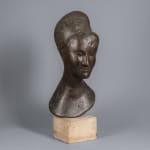Emilio Greco 1913-1995
53 x 23 x 25.5 cm
Emilio Greco grew up in a Sicilian peasant family and worked for a local marble cutter and funerary mason, he trained as a sculptor both in the workshop and academically. The Greek and Roman sculptures in the archaeological museums of Sicily were his prime inspiration and examples throughout his youth. When he first saw Rome he became enamoured with the city and with the Pre-Roman sculptures of the Etruscans, eventually he settled there, and was appointed Professor of Sculpture in 1956.
It is in the post-war period, at the beginning of the fifties, that Greco starts to depict female nudes. It is possible that Head of a Woman was originally modelled in terracotta, and then cast in bronze, as with other sculptures by the artist such as Anna, which is currently held in the National Gallery of Scotland’s collection. The bust represents a strong yet elegant woman’s head on a marble base, characterised by a bold and vigorous cross-hatching technique rare in sculpture and more proper to printmaking, the hair is achieved in brisk pen-strokes of great length and precision, yet very sculptural in their loose expression of form. These bold graphic techniques Greco almost always applied to his sculptures, giving them surfaces that are densely textured rather than polished.
'Greco’s work was entirely figurative, narrative and, though recognisably mannered in style, traditional in its references.' (Ronald Alley, Catalogue of The Tate Gallery's Collection of Modern Art other than works by British Artists, The Tate Gallery in association with Sotheby Parke Bernet, London, 1981, pp.337-8, reproduced p.337). One ecstatic critic of his work in the fifties and sixties opined that youth and beauty were Greco’s religion, and wisdom his companion. Others, not quite as enthusiastic, wrote of spiritual tensions and carefree sensuality alternating with dignified composure and a sense of calm; others still, marginally more sensible, wrote of his expressive line, his sinuous contortions, his use of a single gesture to lend expression to a whole body, his occasional undertones of melancholy, and his references to the sculpture of antiquity and late Renaissance Mannerism.
Provenance
Collection of the late Pat and Penny Allen
Private collection, UK





